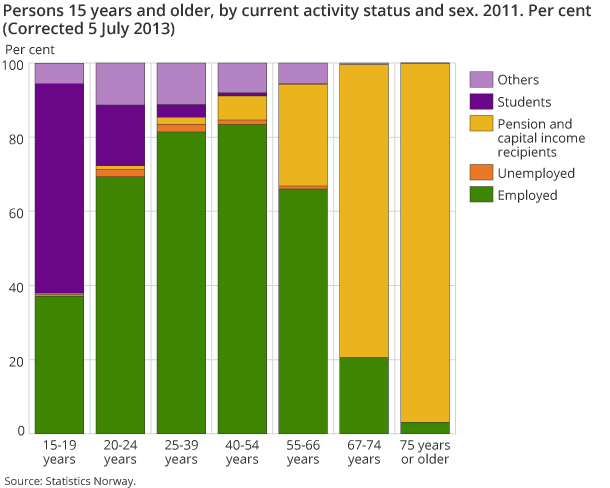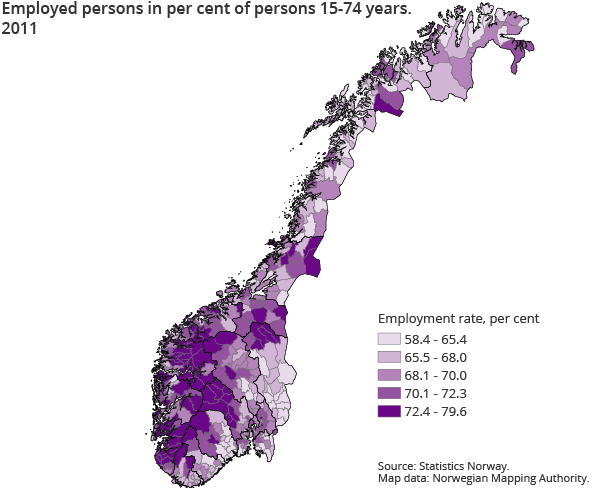Content
Published:
More men than women employed in almost all regions
According to the 2011 population and housing census, the employment rate in the age group 15-74 years was higher for men than for women, with 72 and 67 per cent respectively. This was the situation in all counties and in all but 17 municipalities.
| Total | 15-24 years | 25-66 years | 67 years and over | |
|---|---|---|---|---|
| Numbers | ||||
| Total | 4 056 189 | 654 219 | 2 748 807 | 653 163 |
| Employed persons | 2 572 184 | 349 103 | 2 150 147 | 72 934 |
| Unemployed | 48 105 | 8 307 | 39 756 | 42 |
| Pension or capital income recipients | 863 201 | 4 375 | 280 653 | 578 173 |
| Students | 281 054 | 237 491 | 43 561 | 2 |
| Others | 291 645 | 54 943 | 234 690 | 2 012 |
| Per cent | ||||
| Total | 100.0 | 100.0 | 100.0 | 100.0 |
| Employed persons | 63.4 | 53.4 | 78.2 | 11.2 |
| Unemployed | 1.2 | 1.3 | 1.4 | 0.0 |
| Pension or capital income recipients | 21.3 | 0.7 | 10.2 | 88.5 |
| Students | 6.9 | 36.3 | 1.6 | 0.0 |
| Others | 7.2 | 8.4 | 8.5 | 0.3 |
In 17 out of 429 municipalities the employment rate was higher for women than for men, and 13 of these municipalities were located in the two northernmost counties Troms and Finnmark.
Gender gap has decreased
The difference between employment rates for men and women was smaller in 2011 than 10 years earlier. For the age group 20-74 years the employment rate for men had decreased from 77 to 75 per cent, but for women the rate had increased from 68 to 69 per cent.
Increasing employment rates among the elderly
Employment rates in 2011 were highest for the age group 25-54 years, at more than 80 per cent. For the age group 67-74 years the rate was just 21 per cent, but employment had increased most for this age group over the last 10 years. The rate had almost doubled from 2001 to 2011. For the age group 20-24 years the employment rate was lower in 2011 than in 2001, with 69 compared to 76 per cent.
Lowest employment rates in Østfold, Hedmark and Telemark, highest in Western Norway
For the age group 15-74 years in total, employment rates were lowest for the counties of Østfold, with 64 per cent, and Hedmark and Telemark with 65 per cent. The corresponding rate for the country as a whole was 69 per cent.
The counties of Rogaland and Sogn og Fjordane had the highest employments rates, with 73 per cent. The two other counties in the west, Hordaland and Møre og Romsdal, as well as Akershus in the southeast, also had employment rates above 70 per cent.
When comparing employment rates between regions, the age distribution must be taken into account. Regions with a high portion of elderly will normally have lower employment rates.
Differences between urban districts in Oslo
The employment rate for the capital of Oslo was close to the national average, but there were substantial variations between urban districts. The highest employment rates were found in the most central districts. The suburban districts, especially in the south and east, had much lower rates. Districts in the suburban areas have a higher portion of elderly people than the districts in the inner city.
Type of family has an influence on employment
At the time of the 2011 census, there were 1 123 00 couples living in Norway. Both partners were employed in 60 per cent of these couples, and neither partner was employed in 17 per cent. In the remaining 23 per cent, one of the partners was employed. In 14 per cent of the couples this was a man, and in 9 per cent a woman.
In couples with children, both partners were employed in 78 per cent of cases and neither partner was employed in only 3 per cent of these couples. For couples without children, the corresponding figures were 46 per cent with both partners employed and 28 per cent with neither employed. Since all couples irrespective of age are counted, and only children younger than 18 years are included, it must be taken into consideration that, on average, couples with children 0-17 years are younger than couples without children.
In couples without children where only one of the partners was employed, the employed person was a man in 57 per cent of cases. For couples with children, the corresponding figure was much higher, at 78 per cent. This shows that the presence of children in the family has more influence on employment rates for women than for men.
One in five are pensioners recipents
In population censuses, persons aged 15 years and older who are not employed are classified by current activity status. Persons that are recipients of pensions or capital income are classified as pensioners. According to this classification, 22 per cent of the population aged 15 years and older were pensioners. The portion was higher for women than for men, 25 per cent and 18 per cent respectively. The main explanation is that women live longer than men and that most pensioners are elderly people. However, the portion of pensioners was higher for women than for men in all age groups. The difference between sexes was largest for the age group 67-74 years, with a percentage of 85 per cent for women and 73 for men.
Combining employment and education is common
In the classification by current activity status, students and pupils are considered as being in education only if they are not concurrently employed. For persons 15 years and older, only 7 per cent were classified as being in education and even for the age group 20-24 years the percentage was just 16. The reason is that many persons are combining education and employment.
In the census statistics, 455 000 persons are counted as students. Apprentices and students abroad are not included. For students 16 years and older, the employment rate was 54 per cent, and the rate was increasing by age. For students 19 years and older the employment rate was 66 per cent. The employment rate was higher for women than for men, with 59 and 49 per cent respectively. The difference was largest among the youngest students. For the age group 16-24 years the rate was 51 per cent for women and 40 per cent for men. For students 25 years and older the employment rate was approximately the same for men and women.
Contact
-
Statistics Norway's Information Centre
E-mail: informasjon@ssb.no
tel.: (+47) 21 09 46 42


